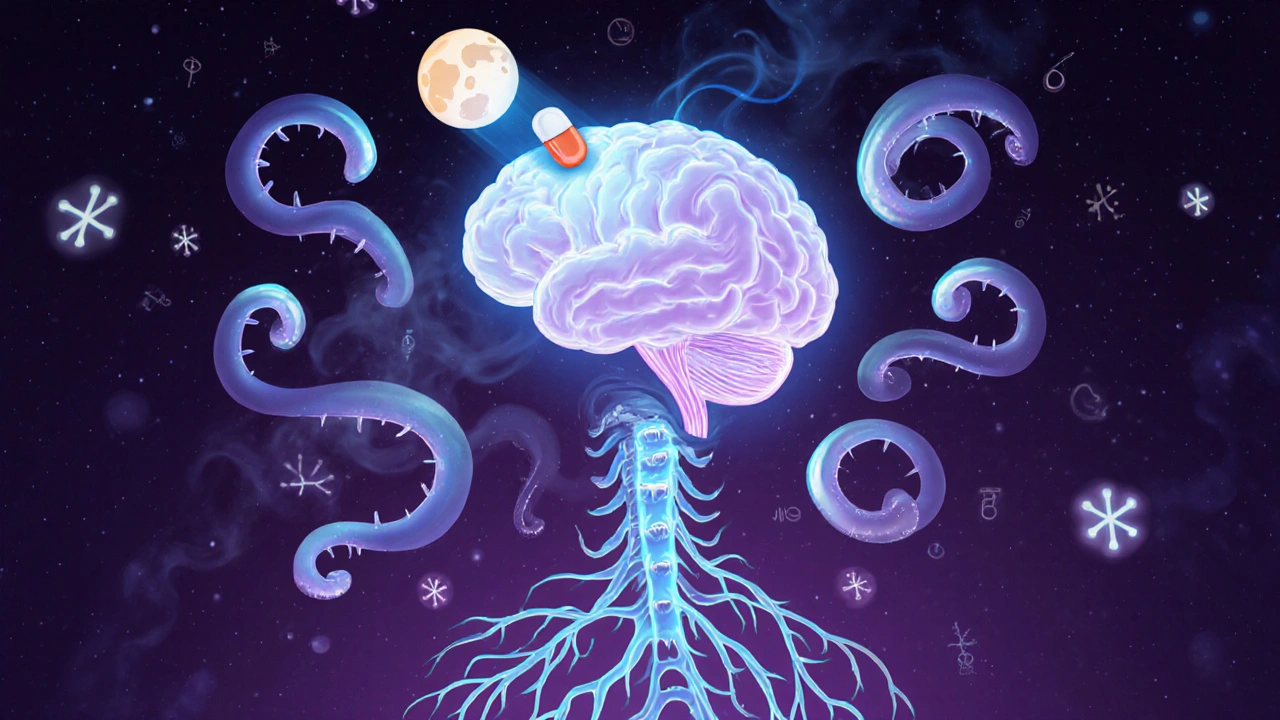When a fungal infection like Candida reaches the brain and spinal cord, it becomes a medical emergency. Candida meningitis is rare but deadly if not treated fast. Fluconazole is one of the most common drugs doctors turn to-and for good reason. It’s not the only option, but it’s often the first because it works, it’s well tolerated, and it crosses the blood-brain barrier better than many other antifungals.
What Is Candida Meningitis?
Candida meningitis is a fungal infection of the membranes surrounding the brain and spinal cord. It’s caused by Candida species, most often Candida albicans. Unlike bacterial or viral meningitis, this form doesn’t spread from person to person. It usually happens when Candida, which normally lives harmlessly in the gut or mouth, gets into the bloodstream and travels to the central nervous system.
This typically happens in people with weakened immune systems. Think: someone on long-term antibiotics, a cancer patient undergoing chemotherapy, a person with advanced HIV, or someone who’s had brain surgery or a spinal tap. Premature babies in neonatal intensive care units are also at risk. In healthy adults, Candida meningitis is almost unheard of.
How Do You Know If It’s Candida Meningitis?
The symptoms look a lot like other types of meningitis, which is why it’s often missed at first. Fever, headache, stiff neck, nausea, and sensitivity to light are the big ones. But here’s what makes it different: symptoms develop slowly. Over days or even weeks. That’s why people might brush it off as a bad migraine or the flu.
Other signs include confusion, trouble concentrating, and in severe cases, seizures or changes in consciousness. Babies might show irritability, poor feeding, or a bulging soft spot on the head. If you’ve had a recent hospital stay, a central line, or a spinal procedure-and now you’re feeling off-don’t wait. A spinal tap (lumbar puncture) is the only way to confirm it. The fluid will show high white blood cells, low sugar, and high protein. Culture or PCR tests will find the Candida.
Why Fluconazole Is the Go-To Treatment
Fluconazole is an azole antifungal. It works by blocking the production of ergosterol, a key building block of fungal cell membranes. Without it, the fungus can’t survive. What makes fluconazole special for meningitis is its ability to reach high levels in the cerebrospinal fluid-up to 80% of the concentration in the blood. Most antifungals can’t do that.
Guidelines from the Infectious Diseases Society of America recommend fluconazole as first-line treatment for Candida meningitis in adults and children. Dosing is usually 400 to 800 mg per day, given intravenously at first, then switched to oral once the patient is stable. Treatment lasts at least two weeks after the cerebrospinal fluid clears of fungus and symptoms improve. For some, that means 6 to 12 weeks total.
Compared to older drugs like amphotericin B, fluconazole causes fewer kidney problems and less fever during infusion. It’s also cheaper and easier to give. That’s why it’s become standard-even in resource-limited settings.

When Fluconazole Isn’t Enough
Not all Candida strains respond to fluconazole. Some, like Candida krusei and Candida glabrata, are naturally resistant. If a patient doesn’t improve after 5 to 7 days on fluconazole, doctors will test the fungus for resistance. In those cases, they’ll switch to drugs like echinocandins (caspofungin) or lipid-based amphotericin B.
For patients with catheters or shunts, removing the source of infection is critical. A spinal shunt or central line that’s infected must come out. Otherwise, even the strongest antifungal won’t cure the meningitis. Surgery isn’t glamorous, but it’s often the missing piece.
Side Effects and What to Watch For
Fluconazole is generally safe. Most people tolerate it well. But it’s not without risks. The most common side effects are nausea, vomiting, stomach pain, and headaches. These are usually mild and go away on their own.
More serious but rare issues include liver damage, allergic reactions, and abnormal heart rhythms. People on multiple medications-especially those metabolized by the liver-need close monitoring. Fluconazole interacts with blood thinners, seizure meds, and some cholesterol drugs. Always tell your doctor what else you’re taking.
Long-term use can cause low potassium or magnesium. Blood tests every few weeks help catch that early. If you feel dizzy, weak, or your heart skips beats, get checked right away.
Can You Prevent Candida Meningitis?
There’s no vaccine. Prevention is about reducing risk. For high-risk patients-like those in the ICU or on long-term antibiotics-doctors may use fluconazole as a preventive (prophylactic) treatment. Studies show this cuts fungal infections by up to 70% in very sick neonates and transplant patients.
Good hygiene matters. Handwashing, clean catheters, and sterile procedures during spinal taps or surgeries reduce the chance of introducing Candida into the bloodstream. For people with HIV, keeping the CD4 count above 200 with antiretroviral therapy lowers the risk of opportunistic infections like this.
Don’t ignore persistent symptoms after hospital discharge. If you had a brain procedure and now have a headache that won’t go away, get it checked. Early diagnosis saves lives.

What Happens After Treatment?
Recovery takes time. Even after the infection clears, some people have lasting issues: memory problems, trouble focusing, or chronic headaches. Physical therapy, cognitive rehab, and regular follow-ups help. Neurological damage from prolonged inflammation doesn’t always reverse.
Doctors will monitor cerebrospinal fluid for recurrence. If fungus comes back, treatment starts again-often with higher doses or longer duration. Some patients need lifelong suppressive therapy, especially if their immune system won’t recover.
Survival rates have improved. In the 1990s, up to 50% of patients died. Today, with early diagnosis and fluconazole, that number has dropped to around 20-30%. But that still means 1 in 4 won’t make it. Speed and accuracy in diagnosis make all the difference.
Fluconazole vs. Other Antifungals
Here’s how fluconazole stacks up against other options:
| Drug | Effectiveness | Brain Penetration | Common Side Effects | Cost (USD/month) |
|---|---|---|---|---|
| Fluconazole | High for susceptible strains | Excellent (80% of blood levels) | Nausea, headache, liver enzyme rise | $150-$300 |
| Amphotericin B | Very high | Moderate | Kidney damage, fever, chills | $1,000-$2,500 |
| Caspofungin | Good, used for resistant strains | Poor | Headache, nausea, liver enzyme rise | $2,000-$4,000 |
| Voriconazole | High, broad spectrum | Good | Vision changes, liver toxicity | $800-$1,500 |
Fluconazole wins on safety, cost, and brain penetration. But if resistance is suspected or the patient is critically ill, doctors start with amphotericin B or echinocandins, then switch to fluconazole once the strain is identified.
When to Call Your Doctor
If you’re at high risk for fungal infections and develop any of these, seek help immediately:
- Fever that won’t break, especially after hospitalization
- Headache that gets worse over days, not hours
- Stiff neck or trouble bending your head forward
- Confusion, memory loss, or personality changes
- Seizures or vision changes
Don’t wait for a headache to turn into a crisis. Candida meningitis is rare-but it doesn’t care if you think it’s "unlikely." It only cares if you get treated in time.
Can fluconazole cure Candida meningitis on its own?
Fluconazole can cure Candida meningitis, but only if the strain is sensitive to it and treatment starts early. In some cases, especially with shunts or catheters, removing the source of infection is just as important as the drug. Doctors often start with stronger antifungals like amphotericin B before switching to fluconazole for long-term treatment.
How long does treatment with fluconazole last for Candida meningitis?
Treatment typically lasts at least two weeks after symptoms improve and the cerebrospinal fluid tests negative for fungus. For most patients, that means 6 to 12 weeks total. Some, especially those with weakened immune systems, need lifelong suppressive therapy to prevent recurrence.
Is fluconazole safe during pregnancy?
Fluconazole is generally avoided during pregnancy, especially in the first trimester. High doses have been linked to birth defects in animal studies and rare cases in humans. If Candida meningitis occurs during pregnancy, doctors usually choose amphotericin B instead, as it’s considered safer for the baby.
Can you get Candida meningitis from taking fluconazole?
No. Fluconazole treats fungal infections-it doesn’t cause them. But if you take it for a long time without proper monitoring, you might develop a resistant strain of Candida. That’s why doctors test for sensitivity and adjust treatment if needed.
What happens if fluconazole doesn’t work?
If there’s no improvement after 5-7 days, doctors will test the fungus for resistance. If the strain is resistant, they’ll switch to drugs like caspofungin, voriconazole, or lipid-based amphotericin B. Removing infected medical devices like shunts or catheters is also critical at this stage.





Tanuja Santhanakrishnan
October 28, 2025 AT 20:59Wow, this is such a clear breakdown-I’ve seen so many patients with lingering headaches after ICU stays and no one connects it to fungal stuff until it’s too late. Fluconazole is a lifesaver in resource-limited places, honestly. I work in a rural hospital in Kerala and we’ve cut mortality by half just by having it on hand. No fancy labs needed, just a good spinal tap and some patience.
Also, props for mentioning prophylaxis in neonates. That’s the quiet hero move-preventing the crisis before it starts.
Raj Modi
October 30, 2025 AT 06:41It is imperative to underscore the clinical significance of antifungal pharmacokinetics in the context of central nervous system infections, particularly with regard to the blood-brain barrier permeability profile of azole derivatives. Fluconazole, owing to its low molecular weight and hydrophilic nature, achieves cerebrospinal fluid concentrations approaching eighty percent of serum levels, a feature which distinguishes it from polyene and echinocandin classes that exhibit markedly inferior penetration. Furthermore, the pharmacodynamic parameters of fluconazole, including its time-dependent fungistatic activity and post-antifungal effect, render it particularly suitable for prolonged suppressive regimens in immunocompromised hosts. The comparative cost-effectiveness analysis presented herein is not merely anecdotal but aligns with WHO essential medicines guidelines, making it a cornerstone of global health strategy in endemic regions.
Sage Druce
October 31, 2025 AT 02:02Fluconazole isn’t perfect but it’s the best tool we’ve got for most cases and if you’re not using it you’re doing your patients a disservice
Stop waiting for perfect diagnostics when the clinical picture screams fungal meningitis. Time kills. Start the drip. Then figure out the strain.
Tyler Mofield
November 1, 2025 AT 02:25Fluconazole resistance is rising in Candida glabrata isolates and failure to initiate combination therapy in immunocompromised patients constitutes a deviation from IDSA guidelines. The absence of amphotericin B as first-line in critical cases represents a therapeutic compromise that may result in increased mortality. Clinical decision-making must be guided by microbiological data not convenience.
Prophylaxis in neonates remains controversial without randomized controlled trials demonstrating long-term neurodevelopmental outcomes.
Patrick Dwyer
November 2, 2025 AT 11:01From a global health equity standpoint, this post does an excellent job highlighting how a low-cost, high-penetration antifungal like fluconazole can bridge gaps in care between high-income and low-resource settings. The table comparing drug costs is especially powerful-amphotericin B at $2500/month versus fluconazole at $300 isn’t just a number, it’s a life-or-death choice for families in sub-Saharan Africa or rural Southeast Asia.
Also worth noting: removing infected catheters isn’t just ‘important’-it’s non-negotiable. No drug can overcome a persistent biofilm on a shunt. That’s surgical wisdom that can’t be replaced by any protocol.
Bart Capoen
November 3, 2025 AT 14:00so i had a friend in med school who got candida meningitis after a spinal tap gone wrong
she was on fluconazole for like 10 weeks and still got migraines for a year after
but she’s alive and kinda normal now
so yeah it works but its not magic
also the side effects? yeah your liver will hate you a little
Susan Karabin
November 4, 2025 AT 14:17It’s wild how something so common in our guts can turn into a brain killer when the body’s defenses fall
Life doesn’t care if you’re healthy or not-it just waits for the crack
Fluconazole is like the quiet firefighter who shows up before the alarm even finishes ringing
Lorena Cabal Lopez
November 5, 2025 AT 14:42Why are we even still using fluconazole as first-line when we have better options? It’s just lazy medicine. Amphotericin B is harsh but it kills everything. This post reads like a pharma ad.
Stuart Palley
November 7, 2025 AT 12:23THIS IS WHY PEOPLE DIE
YOU WAIT FOR TESTS WHEN THE SYMPTOMS ARE CLEAR
FLUCONAZOLE ISN’T THE PROBLEM
THE PROBLEM IS DOCTORS WHO THINK IT’S JUST A MIGRAINE
IF YOU’RE IN THE ICU AND YOUR HEAD HURTS FOR MORE THAN 3 DAYS
GET A LUMBAR PUNCTURE OR I SWEAR TO GOD